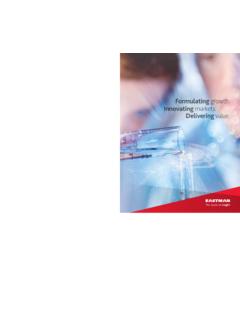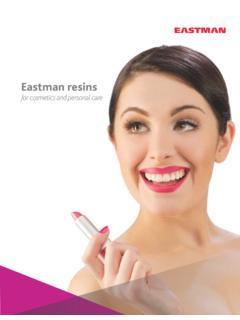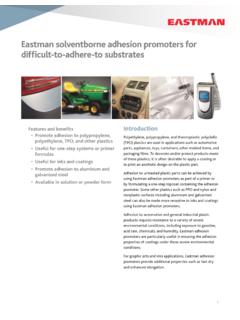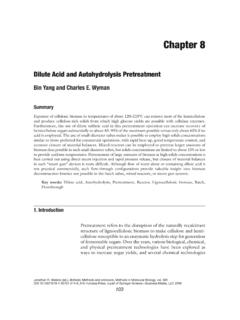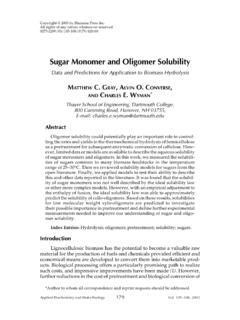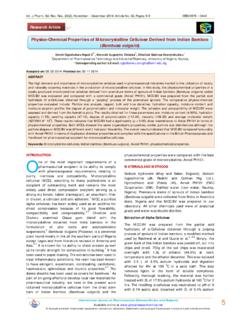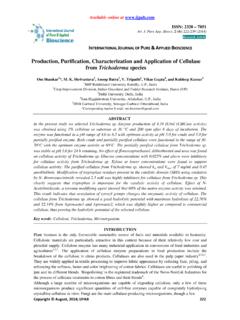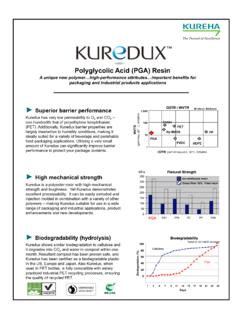Transcription of Eastman cellulose esters—technical tip
1 1 IntroductionAdhesion promoters are an important class of additives which can improve the performance of solventborne flexographic and gravure-applied ink systems. The information provided in this tip describes the types of chemistries which can be successfully used to promote adhesion of CAP ( cellulose acetate propionate) and CAB-based ( cellulose acetate butyrate) printing inks. The three types of additives discussed in the following are useful in promoting adhesion of printing inks on corona-treated substrates including polyethylene, polypropylene, polyester, PVC, and OPS (oriented polystyrene).Although the chemistry of each additive type is different, they all function in a similar manner by reacting with functional chemical groups such as carboxyl groups present on the corona-treated substrates.
2 CAP and CAB-based ink systems are unique among other ink resins in their ability to utilize all three adhesion promoter types. For example, nitrocellulose-based ink systems are unstable and will gel in the presence of PEI (polyethyleneimine) adhesion promoters, and extreme care must be taken to avoid stability problems with PVB-based (polyvinyl butyral) inks when titanium-based adhesion promoters are (polyethyleneimine)PEI is an adhesion promoter widely used in printing inks to improve adhesion to difficult substrates, particularly corona-treated polyolefins such as OPP or polyethylene. PEI adhesion promoters are commonly used in lamination inks where they deliver improved bond strengths. PEI is extremely effective in both PVB and CAP-based inks, but inks based on CAP with unmodified polyethyleneimine are typically unstable and tend to thicken significantly.
3 The pot life is such that these inks are best treated as 2-component cellulose esters technical tipAdhesion promoters for cellulose ester-based inks However, it is possible to greatly improve the pot life of CAP-based inks containing PEI by the addition of AAOT (acetoacet-o-toluidide). The improved pot life is such that negligible viscosity increase was observed over at least 4 months. This level of viscosity stability in CAP inks with polyethyleneimine is unprecedented and allows CAP lamination inks to be manufactured as stable 1-pot inks with no reduction in lamination bond strengths. Best results are achieved when a ratio of 2:1 AAOT to PEI is used. Thus, in a typical formulation containing PEI, the addition of 1% AAOT will result in a stable 1 PEI starting point formulation with Eastman and Eastman cellulose acetate propionate ( ) B72 acrylic C6 citrate AAOT (acetoacet-o-toluidide) Wasserfrei (PEI) Chemical CompanybDow Chemical CompanycSeiber HegnerdBASF22 Eastman cellulose esters technical tip Adhesion promoters for cellulose ester-based inks (Continued}Organic titanatesOrganic complexes of titanium are commonly used to improve adhesion and heat resistance in printing ink formulations.)
4 Typically, such products are based on titanium acetyl acetonate with various modifications to improve color formation, odor, and stability. Organic titanates are very effective when used in cellulose ester-based ink formulations and can provide excellent adhesion particularly on corona-treated polyethylene and polypropylene. Typical addition levels can vary from to 5 wt%. Care must be taken to avoid odor and color formation with organic titanates. Water can also be problematic for titanium complexes. The water content of reducing solvents should be carefully checked to avoid possible hydrolysis which can result in precipitation. Due to these concerns, several ink companies no longer use these products in their 2 Organic titanate containing starting point formulation with Eastman cellulose acetate propionate ( ) 836 acrylic C6 citrate IA10 titanium Chemical CompanybCiba HengerdJohnson Matthey CatalystsZirconium complexesOrganic complexes of zirconium represent an additional group of adhesion promoting compounds commonly used to improve printing ink adhesion.
5 Zirconium acetyl acetonate, propionate, and diethyl citrate chelated zirconium are still used. They are used in a similar manner and addition level to the organic titanates but result in improved odor characteristics and resistance to promoters are an important class of additives which can improve the adhesion performance of ink systems onto various substrates. By utilizing Eastman cellulose esters in the printing ink, the ink formulator has a wider range of available additives compared to other ink-modifying resin systems. Thus, the versatility of Eastman cellulose esters can offer a clear advantage over other resin Chemical CompanyCorporate HeadquartersP. O. Box 431 Kingsport, TN 37662-5280 and Canada, 800- Eastman (800-327-8626)Other Locations, (1) 423-229-2000 Fax: (1) 423-229-1193 Eastman Chemical Latin America9155 South Dadeland 1116 Miami, FL 33156 : (1) 305-671-2800 Fax: (1) 305-671-2805 Eastman Chemical Boulevard 602-6142909 VA Capelle aan den IJsselThe NetherlandsTelephone: (31) 10 2402 111 Fax: (31) 10 2402 100 Eastman (Shanghai) Chemical Commercial Company, Ltd.
6 Jingan Branch1206, CITIC SquareNo. 1168 Nanjing Road (W)Shanghai 200041, ChinaTelephone: (86) 21 6120-8700 Fax: (86) 21 5213-5255 Eastman Chemical Japan Aoyama Building 5F2-11-16 Minami AoyamaMinato-ku, To kyo 107-0062 JapanTelephone: (81) 3-3475-9510 Fax: (81) 3-3475-9515 Eastman Chemical Asia Pacific Pte. Ltd.#05-04 Winsland House3 Killiney RoadSingapore 239519 Telephone: (65) 6831-3100 Fax: (65) 4/13 Although the information and recommendations set forth herein are presented in good faith, Eastman Chemical Company makes no representations or warranties as to the completeness or accuracy thereof. You must make your own determination of their suitability and completeness for your own use, for the protection of the environment, and for the health and safety of your employees and purchasers of your products.
7 Nothing contained herein is to be construed as a recommendation to use any product, process, equipment, or formulation in conflict with any patent, and we make no representations or warranties, express or implied, that the use thereof will not infringe any patent. NO REPRESENTATIONS OR WARRANTIES, EITHER EXPRESS OR IMPLIED, OF MERCHANTABILITY, FITNESS FOR A PARTICULAR PURPOSE, OR OF ANY OTHER NATURE ARE MADE HEREUNDER WITH RESPECT TO INFORMATION OR THE PRODUCT TO WHICH INFORMATION REFERS AND NOTHING HEREIN WAIVES ANY OF THE SELLER S CONDITIONS OF SALE. Material Safety Data Sheets providing safety precautions that should be observed when handling and storing our products are available online or by request. You should obtain and review available material safety information before handling our products.
8 If any materials mentioned are not our products, appropriate industrial hygiene and other safety precautions recommended by their manufacturers should be observed. 2013 Eastman Chemical Company. Eastman is a trademark of Eastman Chemical Company.


